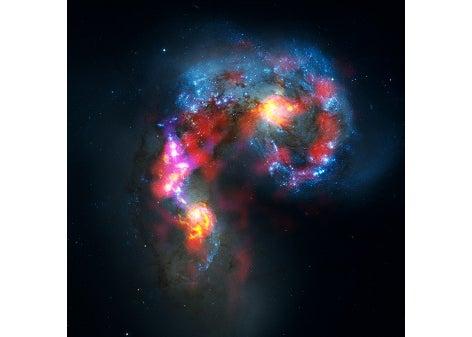New KIPAC Tool Gives Scientists a Closer Look at Merging Galaxies
Scientists at SLAC’s Kavli Institute for Particle Astrophysics and Cosmology (KIPAC) have created sophisticated computer simulations that show galaxy mergers in much more detail than ever before.
By David Reffkin
Scientists at SLAC’s Kavli Institute for Particle Astrophysics and Cosmology (KIPAC) have created sophisticated computer simulations that show galaxy mergers in much more detail than ever before.
On large cosmic scales, galaxies are the fundamental “molecular” units that occupy much of space. Understanding how they gravitationally interact is an important part of astrophysical research, since they can help explain star formation and other phenomena. Central black holes in some galaxies, for example, create huge jets of energy, a mysterious activity that intrigues researchers.
Mergers between galaxies are rare. Based on its relatively undisturbed structure, we can estimate that our own Milky Way galaxy has not been part of any major mergers within the last 10 billion years. When they do happen, they can produce some of the most awe-inspiring images from space. Such events may completely change the size and shape of galaxies, disrupting spiral arms and funneling stars into central bulges. Individual stars are so far apart from each other, however, that an actual collision between two of them is extremely unlikely.
It is difficult to completely resolve the details of two interacting galaxies simply by observing them. So scientists devise computer simulations of millions of galaxies evolving through the history of the universe, hoping to see mergers in process. Impossible to manage by hand, the immense amount of detail involved in these simulations requires special tools for tracking clusters of galactic matter over time. However, current analysis tools can’t differentiate the uniquely individual parts of galaxies during a merger, so the most interesting fine details are lost as the two galaxies become one.
To solve this problem, KIPAC graduate student Peter Behroozi, along with Professor Risa Wechsler and recent KIPAC alumna Heidi Wu, developed a new computational algorithm that uses both position and velocity information to distinguish galaxies in simulations. The algorithm’s formal name is Robust Overdensity Calculation using K-Space Topologically Adaptive Refinement (ROCKSTAR). In essence, the program accounts for the speed, location and direction of the galactic elements. The result is a highly detailed picture of galaxy formation and disruption.
By extension, the algorithm’s measurement of galactic motions will also contribute to the larger study of the mass and energy content of the universe.
This work is based in part on a paper submitted to The Astrophysical Journal, online now on arXiv, and on an article by Peter Behroozi and Jack Singal for the KIPAC “Tidbits” newsletter.
